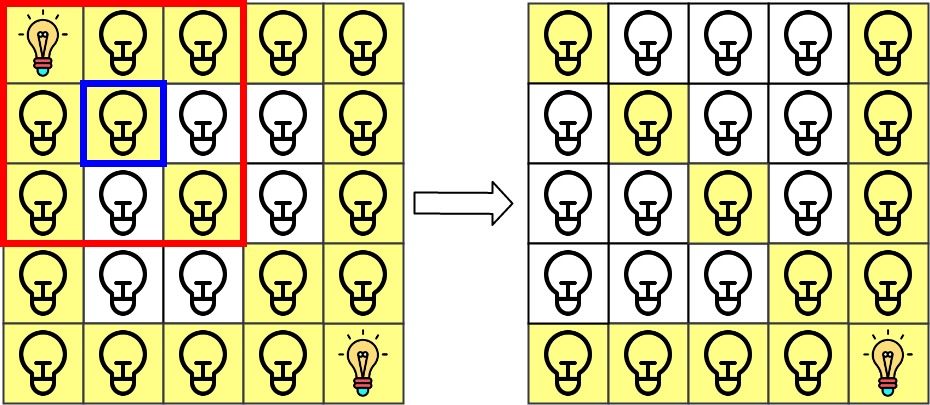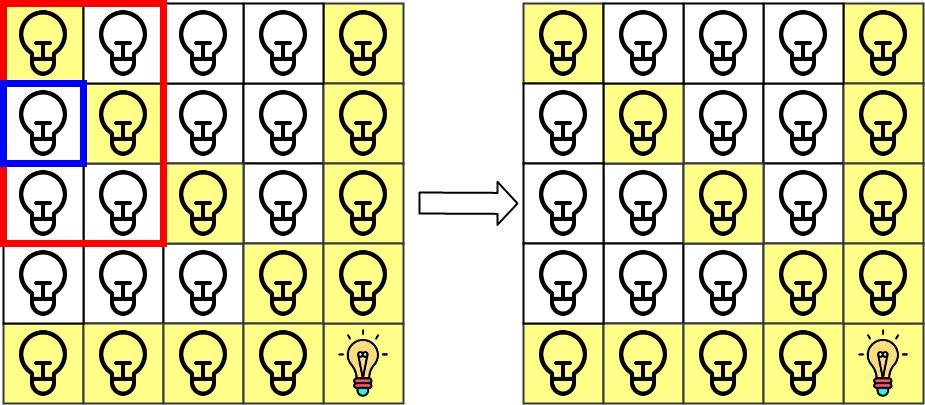


题目描述
在大小为 n x n 的网格 grid 上,每个单元格都有一盏灯,最初灯都处于 关闭 状态。
给你一个由灯的位置组成的二维数组 lamps ,其中 lamps[i] = [rowi, coli] 表示 打开 位于 grid[rowi][coli] 的灯。即便同一盏灯可能在 lamps 中多次列出,不会影响这盏灯处于 打开 状态。
当一盏灯处于打开状态,它将会照亮 自身所在单元格 以及同一 行 、同一 列 和两条 对角线 上的 所有其他单元格 。
另给你一个二维数组 queries ,其中 queries[j] = [rowj, colj] 。对于第 j 个查询,如果单元格 [rowj, colj] 是被照亮的,则查询结果为 1 ,否则为 0 。在第 j 次查询之后 [按照查询的顺序] ,关闭 位于单元格 grid[rowj][colj] 上及相邻 8 个方向上(与单元格 grid[rowi][coli] 共享角或边)的任何灯。
返回一个整数数组 ans 作为答案, ans[j] 应等于第 j 次查询 queries[j] 的结果,1 表示照亮,0 表示未照亮。
示例 1:

输入:n = 5, lamps = [[0,0],[4,4]], queries = [[1,1],[1,0]]
输出:[1,0]
解释:最初所有灯都是关闭的。在执行查询之前,打开位于 [0, 0] 和 [4, 4] 的灯。第 0 次查询检查 grid[1][1] 是否被照亮(蓝色方框)。该单元格被照亮,所以 ans[0] = 1 。然后,关闭红色方框中的所有灯。
 第 1 次查询检查 grid[1][0] 是否被照亮(蓝色方框)。该单元格没有被照亮,所以 ans[1] = 0 。然后,关闭红色矩形中的所有灯。
第 1 次查询检查 grid[1][0] 是否被照亮(蓝色方框)。该单元格没有被照亮,所以 ans[1] = 0 。然后,关闭红色矩形中的所有灯。

示例 2:
输入:n = 5, lamps = [[0,0],[4,4]], queries = [[1,1],[1,1]]
输出:[1,1]
示例 3:
输入:n = 5, lamps = [[0,0],[0,4]], queries = [[0,4],[0,1],[1,4]]
输出:[1,1,0]
提示:
1 <= n <= 1090 <= lamps.length <= 200000 <= queries.length <= 20000lamps[i].length == 20 <= rowi, coli < nqueries[j].length == 20 <= rowj, colj < n
解法
方法一:哈希表
假设一盏灯的坐标为 \((x, y)\),那么它所在的行的数值为 \(x\),列的数值为 \(y\),正对角线的数值为 \(x-y\),反对角线的数值为 \(x+y\)。确定某一直线的唯一数值标识后,我们就可以通过哈希表来记录某一直线所拥有的灯的数目。
我们遍历数组 \(\textit{lamps}\),将当前遍历到的灯所在的行、列和正、反对角线拥有灯的数目分别加 \(1\)。
注意,在处理 \(\textit{lamps}\) 时,需要进行去重,因为我们将重复的灯看作同一盏灯。
接下来,我们遍历 queries,判断当前查询点所在的行,列和正、反对角线是否有灯,如果有,则置 \(1\),即该点在查询时是被照亮的。然后进行关闭操作,查找查询点所在的八近邻点及它本身是否有灯,如果有,将该点所在的行、列和正、反对角线的灯数目分别减 \(1\),并且将灯从网格中去掉。
最后,返回答案数组即可。
时间复杂度 \(O(m + q)\),其中 \(m\) 和 \(q\) 分别为数组 \(\textit{lamps}\) 和 \(\textit{queries}\) 的长度。
1
2
3
4
5
6
7
8
9
10
11
12
13
14
15
16
17
18
19
20
21
22
23
24 | class Solution:
def gridIllumination(
self, n: int, lamps: List[List[int]], queries: List[List[int]]
) -> List[int]:
s = {(i, j) for i, j in lamps}
row, col, diag1, diag2 = Counter(), Counter(), Counter(), Counter()
for i, j in s:
row[i] += 1
col[j] += 1
diag1[i - j] += 1
diag2[i + j] += 1
ans = [0] * len(queries)
for k, (i, j) in enumerate(queries):
if row[i] or col[j] or diag1[i - j] or diag2[i + j]:
ans[k] = 1
for x in range(i - 1, i + 2):
for y in range(j - 1, j + 2):
if (x, y) in s:
s.remove((x, y))
row[x] -= 1
col[y] -= 1
diag1[x - y] -= 1
diag2[x + y] -= 1
return ans
|
1
2
3
4
5
6
7
8
9
10
11
12
13
14
15
16
17
18
19
20
21
22
23
24
25
26
27
28
29
30
31
32
33
34
35
36
37
38
39
40
41
42
43
44
45
46
47
48
49
50
51
52
53
54
55 | class Solution {
private int n;
public int[] gridIllumination(int n, int[][] lamps, int[][] queries) {
this.n = n;
Set<Long> s = new HashSet<>();
Map<Integer, Integer> row = new HashMap<>();
Map<Integer, Integer> col = new HashMap<>();
Map<Integer, Integer> diag1 = new HashMap<>();
Map<Integer, Integer> diag2 = new HashMap<>();
for (var lamp : lamps) {
int i = lamp[0], j = lamp[1];
if (s.add(f(i, j))) {
merge(row, i, 1);
merge(col, j, 1);
merge(diag1, i - j, 1);
merge(diag2, i + j, 1);
}
}
int m = queries.length;
int[] ans = new int[m];
for (int k = 0; k < m; ++k) {
int i = queries[k][0], j = queries[k][1];
if (exist(row, i) || exist(col, j) || exist(diag1, i - j) || exist(diag2, i + j)) {
ans[k] = 1;
}
for (int x = i - 1; x <= i + 1; ++x) {
for (int y = j - 1; y <= j + 1; ++y) {
if (x < 0 || x >= n || y < 0 || y >= n || !s.contains(f(x, y))) {
continue;
}
s.remove(f(x, y));
merge(row, x, -1);
merge(col, y, -1);
merge(diag1, x - y, -1);
merge(diag2, x + y, -1);
}
}
}
return ans;
}
private void merge(Map<Integer, Integer> cnt, int x, int d) {
if (cnt.merge(x, d, Integer::sum) == 0) {
cnt.remove(x);
}
}
private boolean exist(Map<Integer, Integer> cnt, int x) {
return cnt.getOrDefault(x, 0) > 0;
}
private long f(long i, long j) {
return i * n + j;
}
}
|
1
2
3
4
5
6
7
8
9
10
11
12
13
14
15
16
17
18
19
20
21
22
23
24
25
26
27
28
29
30
31
32
33
34
35
36
37
38
39
40
41 | class Solution {
public:
vector<int> gridIllumination(int n, vector<vector<int>>& lamps, vector<vector<int>>& queries) {
auto f = [&](int i, int j) -> long long {
return (long long) i * n + j;
};
unordered_set<long long> s;
unordered_map<int, int> row, col, diag1, diag2;
for (auto& lamp : lamps) {
int i = lamp[0], j = lamp[1];
if (!s.count(f(i, j))) {
s.insert(f(i, j));
row[i]++;
col[j]++;
diag1[i - j]++;
diag2[i + j]++;
}
}
int m = queries.size();
vector<int> ans(m);
for (int k = 0; k < m; ++k) {
int i = queries[k][0], j = queries[k][1];
if (row[i] > 0 || col[j] > 0 || diag1[i - j] > 0 || diag2[i + j] > 0) {
ans[k] = 1;
}
for (int x = i - 1; x <= i + 1; ++x) {
for (int y = j - 1; y <= j + 1; ++y) {
if (x < 0 || x >= n || y < 0 || y >= n || !s.count(f(x, y))) {
continue;
}
s.erase(f(x, y));
row[x]--;
col[y]--;
diag1[x - y]--;
diag2[x + y]--;
}
}
}
return ans;
}
};
|
1
2
3
4
5
6
7
8
9
10
11
12
13
14
15
16
17
18
19
20
21
22
23
24
25
26
27
28
29
30
31
32
33
34
35
36
37 | func gridIllumination(n int, lamps [][]int, queries [][]int) []int {
row, col, diag1, diag2 := map[int]int{}, map[int]int{}, map[int]int{}, map[int]int{}
type pair struct{ x, y int }
s := map[pair]bool{}
for _, lamp := range lamps {
i, j := lamp[0], lamp[1]
p := pair{i, j}
if !s[p] {
s[p] = true
row[i]++
col[j]++
diag1[i-j]++
diag2[i+j]++
}
}
m := len(queries)
ans := make([]int, m)
for k, q := range queries {
i, j := q[0], q[1]
if row[i] > 0 || col[j] > 0 || diag1[i-j] > 0 || diag2[i+j] > 0 {
ans[k] = 1
}
for x := i - 1; x <= i+1; x++ {
for y := j - 1; y <= j+1; y++ {
p := pair{x, y}
if s[p] {
s[p] = false
row[x]--
col[y]--
diag1[x-y]--
diag2[x+y]--
}
}
}
}
return ans
}
|
1
2
3
4
5
6
7
8
9
10
11
12
13
14
15
16
17
18
19
20
21
22
23
24
25
26
27
28
29
30
31
32
33
34
35
36
37
38 | function gridIllumination(n: number, lamps: number[][], queries: number[][]): number[] {
const row = new Map<number, number>();
const col = new Map<number, number>();
const diag1 = new Map<number, number>();
const diag2 = new Map<number, number>();
const s = new Set<number>();
for (const [i, j] of lamps) {
if (s.has(i * n + j)) {
continue;
}
s.add(i * n + j);
row.set(i, (row.get(i) || 0) + 1);
col.set(j, (col.get(j) || 0) + 1);
diag1.set(i - j, (diag1.get(i - j) || 0) + 1);
diag2.set(i + j, (diag2.get(i + j) || 0) + 1);
}
const ans: number[] = [];
for (const [i, j] of queries) {
if (row.get(i)! > 0 || col.get(j)! > 0 || diag1.get(i - j)! > 0 || diag2.get(i + j)! > 0) {
ans.push(1);
} else {
ans.push(0);
}
for (let x = i - 1; x <= i + 1; ++x) {
for (let y = j - 1; y <= j + 1; ++y) {
if (x < 0 || x >= n || y < 0 || y >= n || !s.has(x * n + y)) {
continue;
}
s.delete(x * n + y);
row.set(x, row.get(x)! - 1);
col.set(y, col.get(y)! - 1);
diag1.set(x - y, diag1.get(x - y)! - 1);
diag2.set(x + y, diag2.get(x + y)! - 1);
}
}
}
return ans;
}
|
第 1 次查询检查 grid[1][0] 是否被照亮(蓝色方框)。该单元格没有被照亮,所以 ans[1] = 0 。然后,关闭红色矩形中的所有灯。




